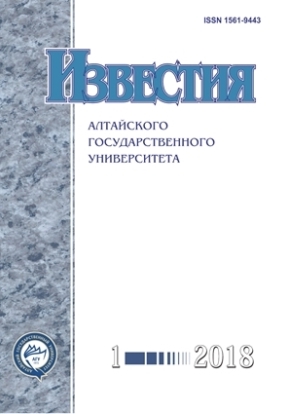Necessary Duration of Molecular Dynamics Simulation for Calculation of Self-Diffusion Coefficient during Migration of Different Point Defects in Nickel
Abstract
The evaluation of the necessary duration of molecular dynamics experiment for the calculation of the selfdiffusion coefficient during migration of different point defects in Ni (vacancy, bivacancy, self-interstitial atom, hydrogen atom) is conducted in this paper. The mentioned defects have different mobility that results in different intensities of atoms displacements caused by migration of the defect. The accuracy of diffusion coefficient calculation is related to the accuracy of estimation of rootmean-square changes of atoms coordinates. Consequently, the accuracy increases with the increase of moleculardynamic experiment duration t, the temperature T, and the mobility of the defect initiating the diffusion. To describe the interatomic interactions, the multi-particle Cleri-Rosato potential is used in the study. It is shown that the simulation duration of 100 ps is enough to calculate the diffusion coefficient when the temperature is higher than 0.6 of melting point. When calculating the diffusion coefficient of impurity in a metal crystal (for example, the hydrogen impurity), it is possible to decrease the root mean square error of displacement evaluation of impurity atoms by increasing the number of impurity atoms.
DOI 10.14258/izvasu(2018)1-06
Downloads
Metrics
References
Suzuki A., Mishin Y. Atomistic modeling of point defects and diffusion in copper grain boundary // Interface Science. — 2003. — №11. — P. 131–148.
Liu C.L., Plimpton S.J. Molecular-statics and moleculardynamics study of diffusion along [001] tilt grain boundaries in Ag // Physical Review B. — 1995. — V. 51. — P. 4523–4529.
Frolov T., Mishin Y. Molecular dynamics modeling of self-diffusion along a triple junction // Physical Review B. — 2009. — V. 79. — 174110.
Poletaev G.M., Starostenkov M.D. Contributions of different mechanisms of self-diffusion in face-centered cubic metals under equilibrium conditions // Physics of the Solid State. — 2010. — V. 52, №6, P. 1146–1154.
Lipnitskii A.G., Nelasov I.V., Kolobov Yu.R. Self-Diffusion Parameters of Grain Boundaries and Triple Junctions in Nanocrystalline Materials // Defect and Diffusion Forum. — 2011. — V. 309–310. — P. 45–50.
Upmanyu M., Srolovitz D.J., Shvindlerman L.S., Gottstein G. Molecular dynamics simulation of triple junction migration // Acta Materialia. — 2002. — V. 50. — P. 1405–1420.
Mendelev M.I., Deng C., Schuh C.A., Srolovitz D.J. Comparison of molecular dynamics simulation methods for the study of grain boundary migration // Modelling and Simulation in Materials Science and Engineering. — 2013. — V.21. — 045017.
Zhang H., Upmanyu M., Srolovitz D.J. Curvature driven grain boundary migration in aluminum: molecular dynamics simulations // Acta Materialia. — 2005. — V. 53. — P. 79–86.
Trautt Z.T., Mishin Y. Grain boundary migration and grain rotation studied by molecular dynamics // Acta Materialia. — 2012. — V. 60. — P. 2407–2424.
Poletaev G.M., Starostenkov M.D., Dmitriev S.V. Interatomic potentials in the systems Pd-H and Ni-H // Materials Physics and Mechanics. — 2016. — V. 27, №1. — P. 53–59.
Cleri F., Rosato V. Tight-binding potentials for transition metals and alloys // Physical Review B. — 1993. — V. 48., №1 — P. 22–33.
Poletaev G.M., Novoselova D.V., Kaygorodova V.M. The causes of formation of the triple junctions of grain boundaries containing excess free volume in fcc metals at crystallization // Solid State Phenomena. — 2016. — V. 249. — P. 3–8.
Copyright (c) 2018 Г.М. Полетаев, В.В. Коваленко, Н.М. Гурова, М.А. Ильина

This work is licensed under a Creative Commons Attribution 4.0 International License.
Izvestiya of Altai State University is a golden publisher, as we allow self-archiving, but most importantly we are fully transparent about your rights.
Authors may present and discuss their findings ahead of publication: at biological or scientific conferences, on preprint servers, in public databases, and in blogs, wikis, tweets, and other informal communication channels.
Izvestiya of Altai State University allows authors to deposit manuscripts (currently under review or those for intended submission to Izvestiya of Altai State University) in non-commercial, pre-print servers such as ArXiv.
Authors who publish with this journal agree to the following terms:
- Authors retain copyright and grant the journal right of first publication with the work simultaneously licensed under a Creative Commons Attribution License (CC BY 4.0) that allows others to share the work with an acknowledgement of the work's authorship and initial publication in this journal.
- Authors are able to enter into separate, additional contractual arrangements for the non-exclusive distribution of the journal's published version of the work (e.g., post it to an institutional repository or publish it in a book), with an acknowledgement of its initial publication in this journal.
- Authors are permitted and encouraged to post their work online (e.g., in institutional repositories or on their website) prior to and during the submission process, as it can lead to productive exchanges, as well as earlier and greater citation of published work (See The Effect of Open Access).








